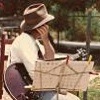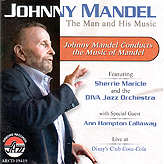Home » Jazz Articles » Live Review » Nnenna Freelon Live At The Saville Theater, San Diego
Nnenna Freelon Live At The Saville Theater, San Diego

Saville Theater, San Diego City College
San Diego, CA
November 9, 2010
Vocalist Nnenna Freelon has enjoyed her share of commercial success over the years (she's been nominated for six Grammy Awards), but not enough to damage her artistic integrity. She's got one hell of a voice, which she employs to great effect by never overdoing it. She has the innate ability to organize most of her phrasing just a fraction behind the beat—something jazz musicians have been doing for years to enhance the swing factor. Freelon has also learned to tell a story with the lyrics she's singing—both with her vocal delivery and poetic use of her arms and hands during her performance.
Touring in support of her seventh Concord release, Homefree (2010), Freelon arrived early to rehearse her San Diego/Los Angeles group. On piano, Mike Garson is the definition of eclectic: he's recorded several albums of avant-garde music, but he's more known for his various forays into the world of rock music, most notably his tenure with singer David Bowie. Garson has also contributed to the music of the Smashing Pumpkins, and Nine Inch Nails. He has played with Freelon before and it showed. San Diego heavyweight Bob Magnusson was on double-bass, while the omnipresent Duncan Moore was on drums.
The trio gathered onstage first, to warm the audience up and set the stage for Freelon's appearance with a wild and elastic version of "All Blues." They ventured far afield upon reaching the turnaround, often reharmonizing or treated it chromatically to heighten the tension. It even got free for a short period. Garson referenced the melody obliquely throughout, then unwound with a long solo that built towards the introduction of crashing block chords and manic right hand trilling. Magnusson followed with one of his trademarked warm, pliant solos; each note telling a story. Moore kept up a constant commentary in dialogue with the pianist—he seemed especially animated the entire evening, rattling off a percussive discourse—and started trouble whenever the moment demanded it.
Freelon walked onstage dressed in black, and cut quite a figure; she's got that rare combination of beauty, experience and truth. She counted off a slow, smoldering version of "Blue Skies," and it was obvious from the first few notes that she was the real deal. Everything about her delivery was authentically soulful; she bent lots of notes but in a subtle, always musical fashion. After a deft scat solo, Garson opened things up with inventive piano flourishes. Magnusson's turn was filled with tasteful chops and honey-dripped timbre—every time he picks up the bass, he sings his own song. Following was a dark, funk reading of "You and the Night and the Music," where it was unusual to hear that melody in straight-eight phrasing, and a relief when they transitioned into a swing groove at the halfway point.
Next up was the slow-as-molasses, "I Didn't Know What Time It Was." Freelon owned this song, making the lyrics seem personal and therefore all the more poignant. Magnusson's whole-notes growled and moaned and Moore's brush-work shadings completed the emotional experience. Such solemnity was relieved by the relative absurdity of "If I Only Had a Brain," from the The Wizard Of Oz. Freelon's playful take on this one had the crowd chuckling along, especially at the end, when she dangled her arm back and forth—just like the scarecrow.
Perhaps the highlight of the evening came with a gorgeous reading of the Antonio Carlos Jobim classic, "Dindi." She began with the rarely heard verse, a cappella, before launching the quartet into the slow Brazilian groove, over which she soared and swooped and emoted with dignity and wisdom. The band followed a path illuminated by Magnusson's supple guidance, and Garson lit things up with a well paced lyric story of his own.
Garson and Moore exited the stage, leaving Freelon and Magnusson for a one-on-one opportunity. The two knocked it out of the park with a ravishing take on the Hoagy Carmichael gem, "Skylark." Magnusson opened with a bass vamp full of slurs and bluesy turn-backs, and when Freelon joined in, it was magical. She's been singing this tune forever—long enough to truly reinvent it each time out. "Skylark" was an essay in spontaneous creation on a very old form.
Freelon then induced the men in the audience into a mercifully brief refrain of "I Feel Pretty," from West Side Story. When the quartet joined in, it was with a creatively off-centered take on the well-worn show tune. Plenty of tension was established with the dissonant chord voicings and choppy rhythms, and lots of relief was felt when they broke into an easy swing at midpoint. Garson whipped out a powerful, dense piano solo, climaxing with right hand trills and left-hand volleys.
The evening continued with the perfectly paced, mid-tempo swing of, "Smile." Once again, Freelon infused the Charlie Chaplin standard with an emotional understanding that was appropriately reflective, rather than sappy. Garson and Moore were in lockstep with each other all evening, and especially on this piece. Garson kept looking Moore's way and teasing out additional drum-set commentary. They were obviously having a blast, and their joy spilled into and over the audience.
It all had to end sooner or later, and it did, on a high note, with a truly off-kilter arrangement of the Ellington/Strayhorn vehicle, "It Don't Mean A Thing." They started out sounding like 1930s German cabaret, all choppy and square. Freelon seemed to enjoy putting the audience on with her stilted, mechanical delivery. Of course it was all a ruse— just a setup for the inevitable "swing-fest" that followed. Magnusson laid down a "Detroit" solo (all walking bass), and Moore was given wide latitude to create an explosive, roiling drum soliloquy that was the perfect segue into Garson's wild, Art Tatum meets Cecil Taylor piano episode. After Freelon returned to "take the tune out," a long, loud ovation ensued.
Photo Credit
Michael Oletta
Tags
Nnenna Freelon
Live Reviews
Robert Bush
United States
Mike Garson
Bob Magnusson
Duncan Moore
Antonio Carlos Jobim
Hoagy Carmichael
Art Tatum
Cecil Taylor
PREVIOUS / NEXT
Nnenna Freelon Concerts
Support All About Jazz
 All About Jazz has been a pillar of jazz since 1995, championing it as an art form and, more importantly, supporting the musicians who make it. Our enduring commitment has made "AAJ" one of the most culturally important websites of its kind, read by hundreds of thousands of fans, musicians and industry figures every month.
All About Jazz has been a pillar of jazz since 1995, championing it as an art form and, more importantly, supporting the musicians who make it. Our enduring commitment has made "AAJ" one of the most culturally important websites of its kind, read by hundreds of thousands of fans, musicians and industry figures every month.
























